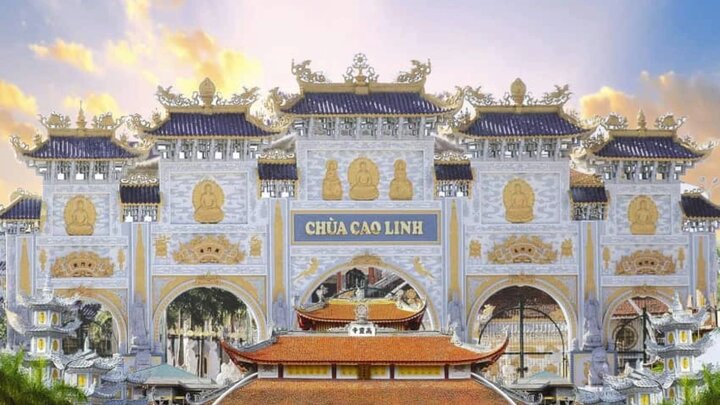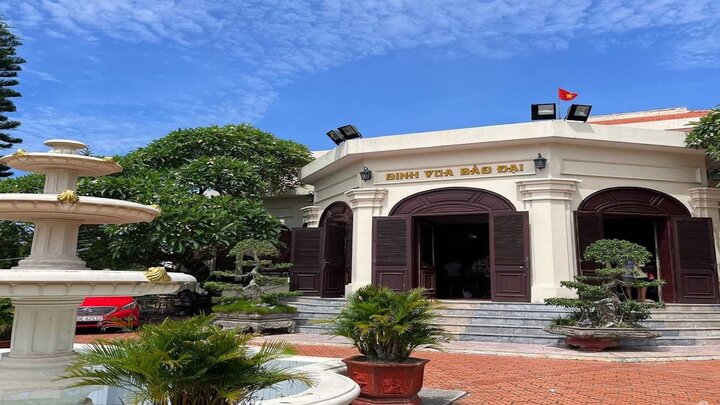1. Overview of Chua Cao Linh Hai Phong Pagoda
1.1. Geographical location and scale of Chua Cao Linh Pagoda
Chua Cao Linh Hai Phong Pagoda holds a prominent position in the western gateway area of the city. Just about 12 km from the center of Hai Phong, it is very convenient to travel here thanks to National Highway 10 and National Highway 5 systems, suitable for visitors from Hanoi as well as neighboring provinces.
The total area of up to 49,000 m² makes the pagoda a large spiritual complex of Hai Phong. The open space harmonizes with large-scale constructions, peaceful stupa gardens, and clear blue water reflecting the sky and clouds. Amidst the dynamic industrial life, the pagoda is a place of peace and tranquility creating a special sense of peace for every visitor.
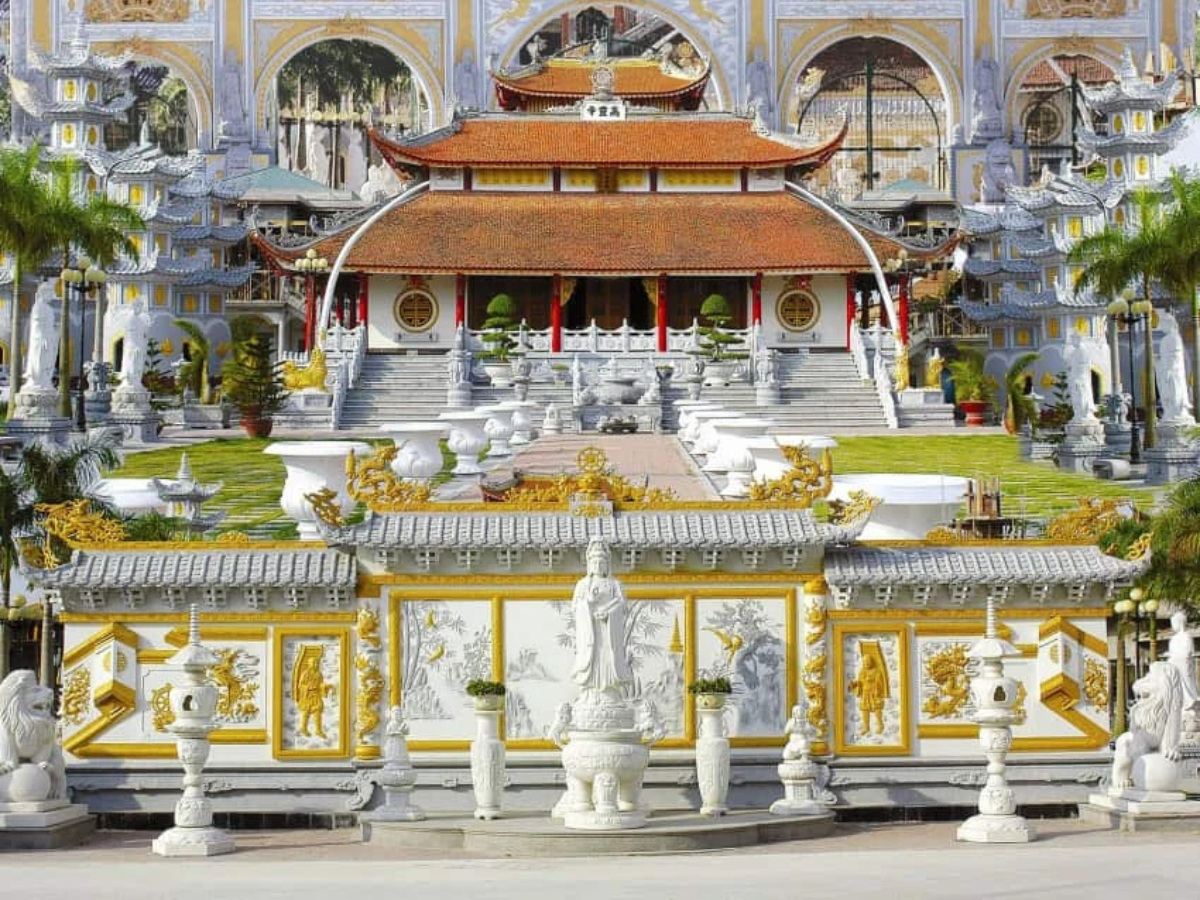
Unique architectural features at Cao Linh Pagoda, Hai Phong. (Source: Collected)
1.2. What makes Cao Linh Pagoda, Hai Phong stand out in 2026?
Having existed for over 300 years, Cao Linh Pagoda, Hai Phong is a place that preserves rich historical stories associated with the port land. Not only a place of worship, the pagoda once played an important role during the resistance period, serving as a safe stop for revolutionary cadres operating in secret.
The pagoda's architecture is a unique blend of Eastern traditional features and a touch of Western modern influence, creating a distinctive, unmistakable character. From the imposing Ngu Quan Gate, the solemn Dai Hung Bao Dien, to the 3.2-ton bronze bell that resonates far throughout the pagoda, each structure holds commendable artistic value.
In 2026, many cultural and spiritual activities will take place at the pagoda. Major celebrations for Buddha's Birthday and Vu Lan will be organized along with new programs for visitors. This is a time worth experiencing, when all the spiritual values and traditional beauty of the pagoda are fully showcased.
2. History of formation and development of Cao Linh Pagoda, Hai Phong
2.1. Origin and initial construction process
According to historical records, Cao Linh Pagoda, Hai Phong appeared during the Later Lê Dynasty. The Le Van family in the former Ha Lien village, now Bac Ha hamlet, were instrumental in building this pagoda to express their wishes for peace and development for the then undeveloped land.
The initial architecture was heavily inspired by Northern Vietnamese style, featuring a three-bay front hall, a five-bay ancestral house, and a two-bay inner sanctuary. The pagoda's curved roof and intricately carved wooden roof trusses exuded an ancient charm. The area around the pagoda was lush green rice fields and old bamboo groves, creating a simple, peaceful scene closely associated with traditional agricultural life.
2.2. Special historical role during the resistance
During the resistance against the French, Cao Linh Pagoda, Hai Phong played a crucial role for the local revolution. Its quiet atmosphere and discreet location made it a place for hiding cadres, supplying food, and serving as a safe communication point.
After being devastated by the French colonialists, many old architectural sections of the pagoda were severely damaged. However, the resilience of the people contributed to the pagoda's restoration after liberation.
A major renovation in 2011 brought a new appearance with structures such as the Ngu Quan Gate, Dai Hung Dien, Tower Garden, and La Han Duong. These structures not only preserve historical value but also aim for development, positioning the pagoda as a modern spiritual center in the region.
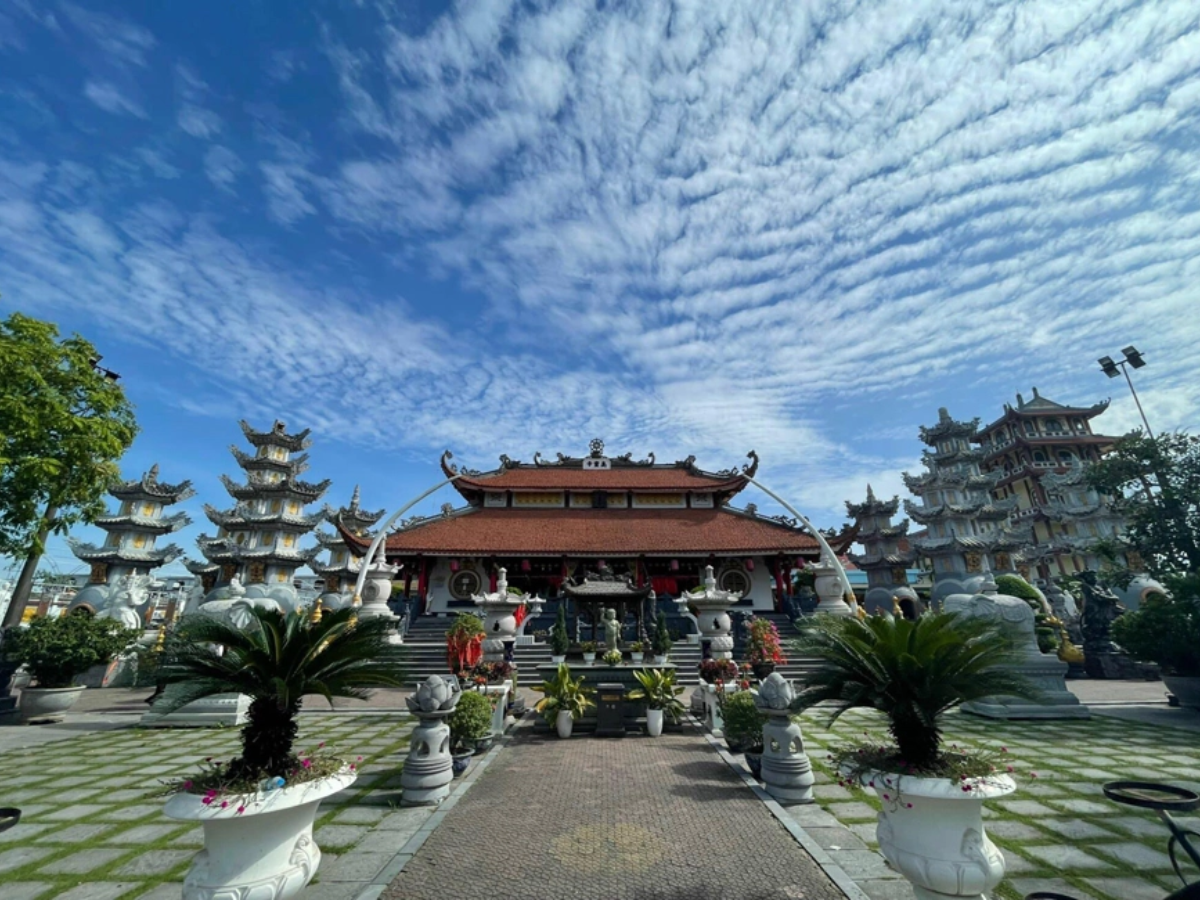
Cao Linh Pagoda currently after renovation. (Source: Collected)
3. Discover the architecture and artistic highlights at Cao Linh Pagoda Hai Phong
3.1. Unique architectural style blending tradition and modernity
Upon arriving at Cao Linh Pagoda Hai Phong , visitors can easily feel the harmonious blend between Eastern traditional architecture and Western modernity. The gracefully curved tiled roofs, imbued with the identity of the North and combined with new construction techniques, create an overall structure that is both ancient and contemporary.
The dominant white and yellow colors enhance the solemnity of the entire pagoda complex. Many prominent artistic details, such as the Dharma wheel symbolizing reincarnation and lotus flowers on the roof symbolizing purity, are all meticulously carved. Dragons and phoenixes on the roof edges soar, symbolizing the strong and sacred spirit of this place.
3.2. Iconic structures not to be missed at Cao Linh Pagoda
The Ngu Quan Gate welcomes visitors with a five-pathway design, symbolizing each person's five senses. The carved details on the stone pillars are meticulously crafted, showcasing the artisans' skill. This gate is not just an entrance but also symbolic, marking the boundary between the mundane world and the sacred realm.
The Dai Hung Bao Dien is the center of Cao Linh Pagoda Hai Phong , built in the shape of the Vietnamese letter 'Dinh' (丁), consisting of three front halls and one rear sanctuary. Its three-tiered roof soars high, housing statues of Sakyamuni Buddha and Bodhisattvas. This place is always filled with the scent of incense, the sound of chanting for peace, and the warm glow of candles.

The Great Buddha Hall (Dai Hung Bao Dien) is the center of Cao Linh Pagoda (Chua Cao Linh). (Source: Collected)
The Tower Garden and Arhat Hall evoke a deep sense of spiritual space. The stone towers, where the cremains of the abbots are kept, are intricately carved with dragons and phoenixes, surrounded by greenery, creating a profound tranquility for this ancient pagoda in Hai Phong. The Arhat Hall houses statues of Arhats and displays exquisite sculptures rich in aesthetic value.
Another distinctive feature of Cao Linh Pagoda (Chua Cao Linh) is its 3.2-ton bronze bell. This is a proud highlight, with its sound echoing throughout the region. Every time the temple bell rings, people feel peace, purity, and their souls awakened in the sacred space.
4. Spiritual Experiences and Cultural Activities at Cao Linh Pagoda Hai Phong (Chua Cao Linh Hai Phong)
4.1. Major Ceremonies and Annual Buddhist Festivals
On occasions like Buddha's Birthday, Ullambana Festival, or the New Year's prayer ceremony, Cao Linh Pagoda Hai Phong (Chua Cao Linh Hai Phong) becomes bustling with crowds from all over coming to attend. The sacred atmosphere fills the entire premises, with chanting, incense smoke, and candlelight creating a warm scene.
The Buddha's Birthday ceremony is solemnly held with rituals such as the Buddha bathing ceremony, lantern procession, and releasing birds. Visitors to the pagoda can not only witness but also participate in these meaningful activities. The Ullambana Festival is a time for descendants to reunite, pray together, and express filial piety to their ancestors.
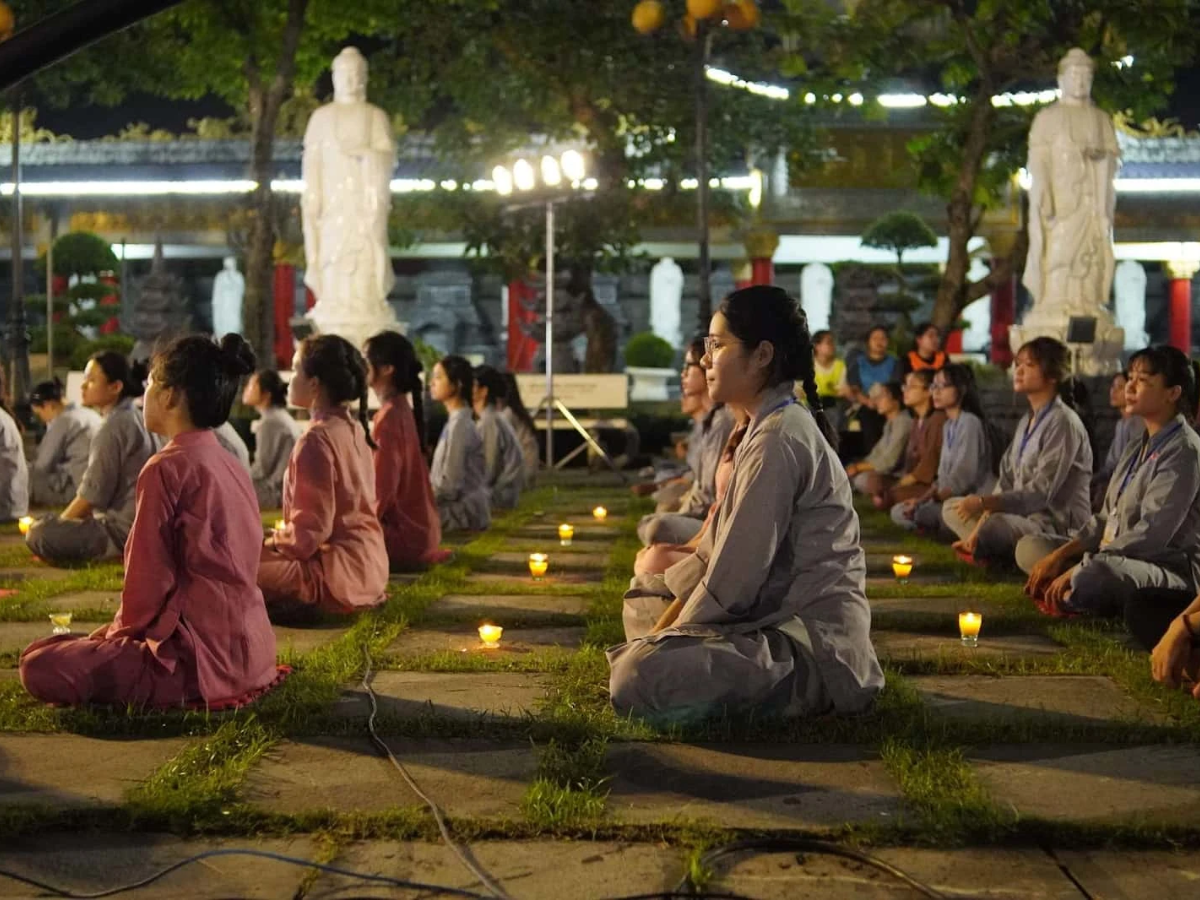
Everyone comes to Cao Linh Pagoda to attend the ceremony. (Source: Collected)
4.2. Role of the pagoda in education, preserving the identity of the port region
Besides the spiritual aspect, Cao Linh Pagoda Hai Phong is also a place to impart moral values to the community. Buddhist doctrine classes and summer retreats for youth are organized regularly. Lessons about life, love, and morality are conveyed vividly and closely.
The pagoda is a place for many meaningful charitable activities, such as giving gifts to the poor, supporting students in difficulty, and caring for lonely elderly people. These actions contribute to spreading compassion and fostering solidarity in the local community. Thanks to these humane activities, the pagoda is not only a pure spiritual place but also becomes a spiritual support, a place connecting love and sharing between people in modern life.
4.3. Unique experiences for tourists in 2026
In 2026, Cao Linh Pagoda Hai Phong offers many new activities to make an impression on visitors. People can experience short meditation courses, learn to listen and relax their minds in the quiet space of the pagoda. International Buddhist exchange sessions are also organized, helping international tourists understand Vietnamese culture better.
Exquisitely designed photo areas around the Tower Garden, the row of Arhat statues, and the large bronze bell allow visitors to capture beautiful moments while maintaining reverence. New spiritual education programs are also added, helping visitors understand more deeply the spiritual values of Buddhism and the traditions of the port region.

Unique architecture for visitors to freely check-in. (Source: Collected)
5. Journey to explore Cao Linh Pagoda and notable tourist attractions in Hai Phong
After visiting and worshipping at Cao Linh Pagoda Hai Phong, if time permits, visitors can continue their journey to the city center or travel to Cat Ba Island by the Sun World Cat Ba cable car system. Here, you will admire the panoramic view of Lan Ha Bay, experience swimming, or enjoy attractive seafood dishes.

Tourists excitedly experience Sun World Cat Ba.
Additionally, tourists can also visit places like Bach Dang Giang, Do Son beach, or Nam Hai sea area to enrich their experience. Each place has its own cultural characteristics, contributing to the distinctive character of Hai Phong tourism.
Cao Linh Pagoda in Hai Phong is not only a spiritual destination but also a cultural symbol and spiritual heritage of the port land. Every corner of the pagoda evokes a sense of peace, guiding people towards a virtuous life. Take time to visit, feel the peaceful atmosphere here, and share experiences with the spiritual tourism community in 2026.

